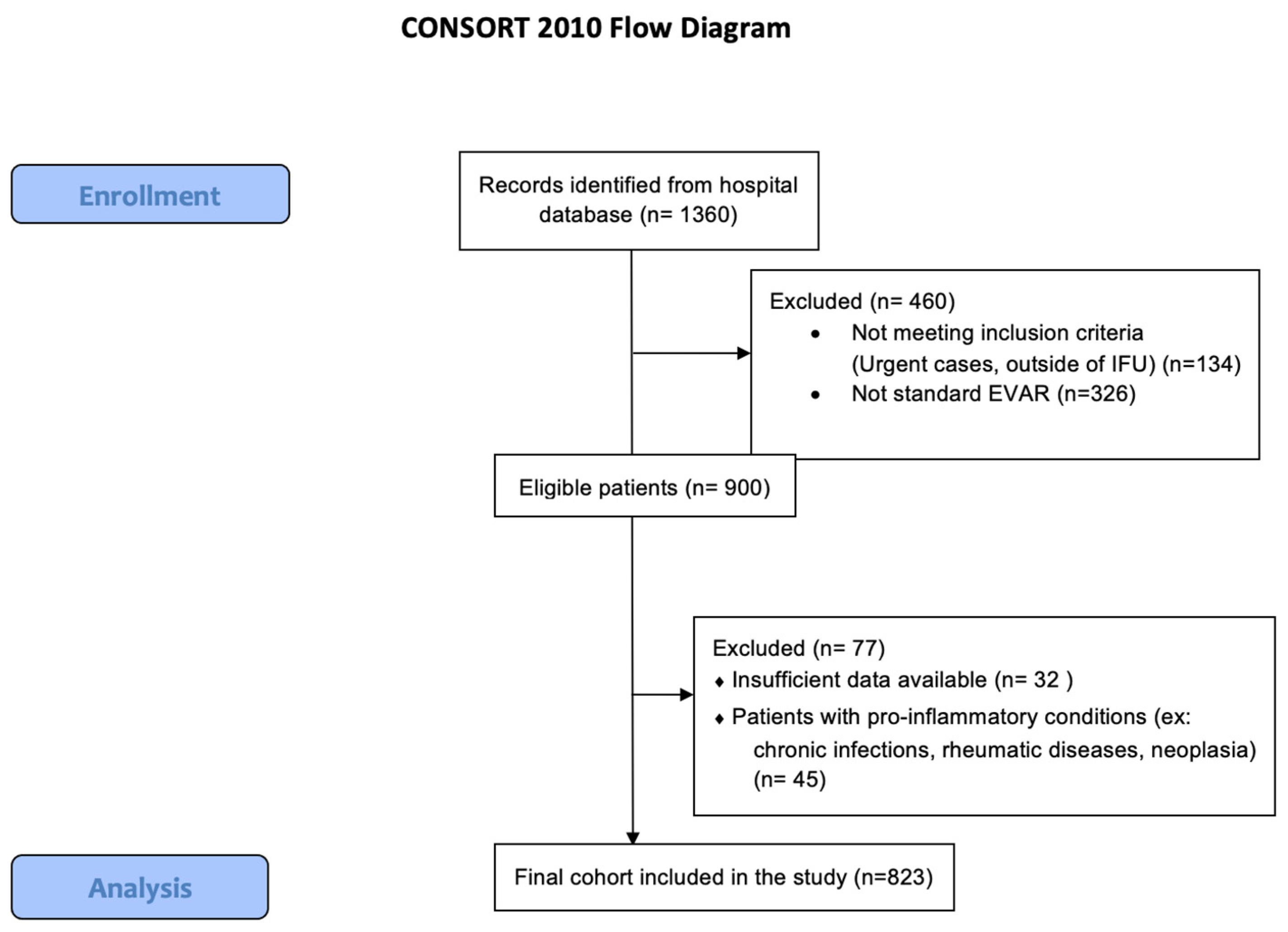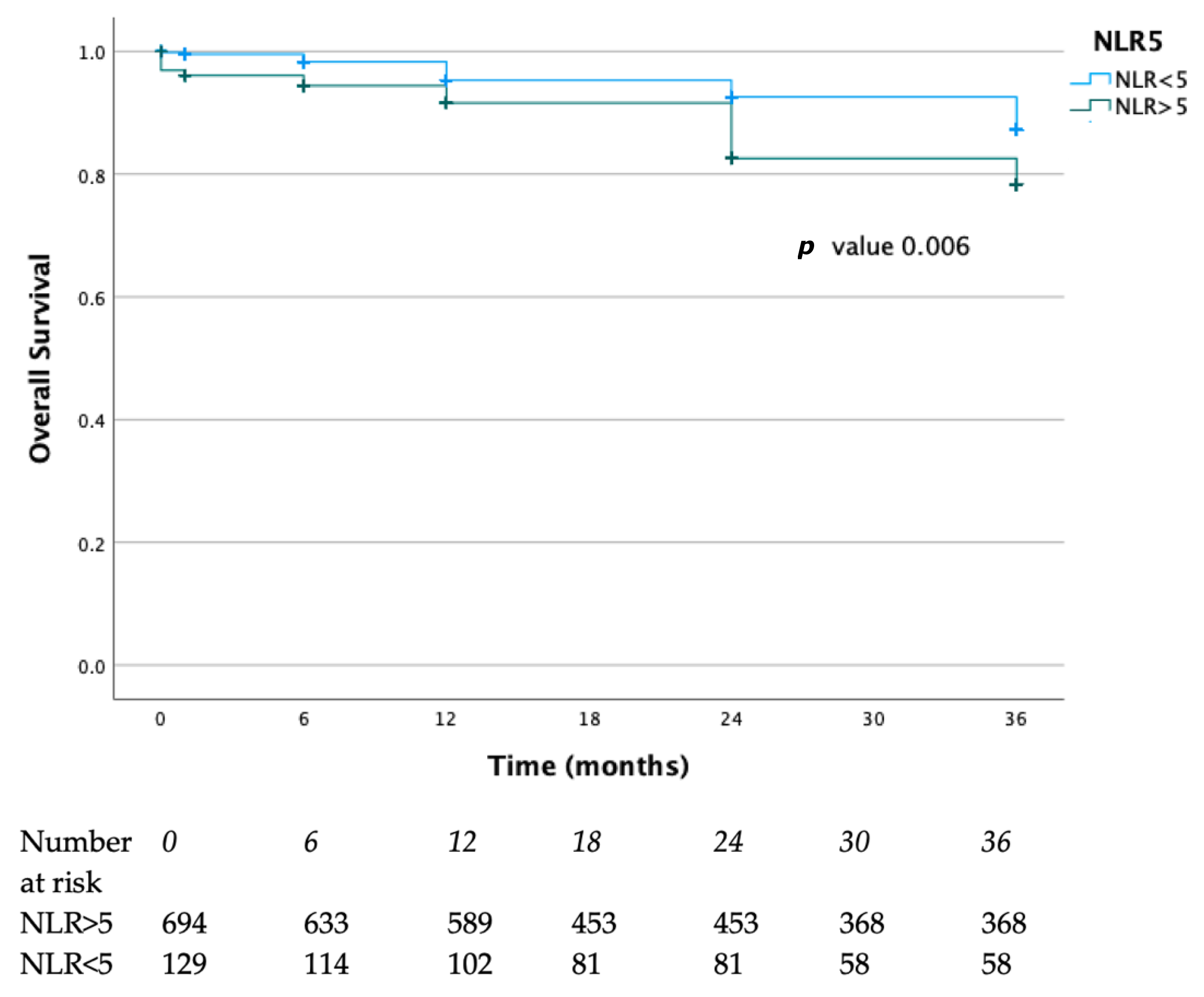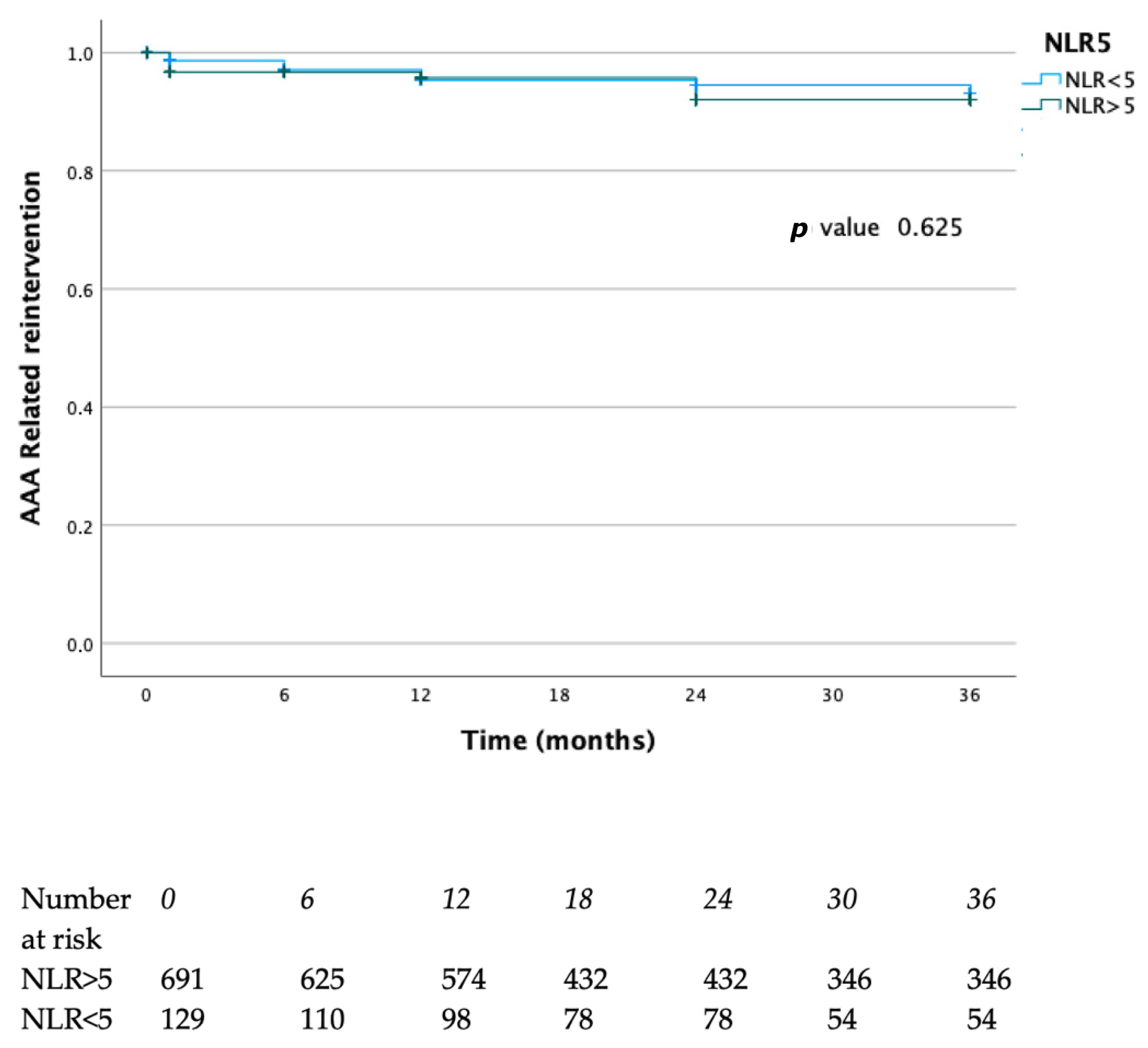Neutrophil-to-Lymphocyte Ratio as Potential Marker of Outcome After Standard EVAR
Abstract
1. Introduction
2. Materials and Methods
2.1. Preoperative Work-Out
2.2. Follow-Up Protocols
2.3. Study Outcomes
2.4. Statistical Analysis
3. Results
4. Discussion
5. Conclusions
Author Contributions
Funding
Institutional Review Board Statement
Informed Consent Statement
Data Availability Statement
Conflicts of Interest
Abbreviations
| AAA | Abdominal Aortic Aneurysm |
| ALI | Acute Limb Ischemia |
| ASA | American Society of Anesthesiologists (Classification) |
| CAD | Coronary Artery Disease |
| CI | Confidence Interval |
| CKD | Chronic Kidney Disease |
| COPD | Chronic Obstructive Pulmonary Disease |
| CT | Computed Tomography |
| DM | Diabetes Mellitus |
| DUS | Duplex Ultrasound |
| EVAR | Endovascular Aneurysm Repair |
| HTN | Hypertension |
| ICU | Intensive Care Unit |
| IFU | Instructions for Use |
| IQR | Interquartile Range |
| NLR | Neutrophil-to-Lymphocyte Ratio |
| OR | Odds Ratio |
| SARS-CoV-2 | Severe Acute Respiratory Syndrome Coronavirus 2 |
| SD | Standard Deviation |
| SPSS | Statistical Package for Social Sciences |
| TIA | Transient Ischemic Attack |
References
- Bhat, T.; Teli, S.; Rijal, J.; Bhat, H.; Raza, M.; Khoueiry, G.; Meghani, M.; Akhtar, M.; Costantino, T. Neutrophil to lymphocyte ratio and cardiovascular diseases: A review. Expert. Rev. Cardiovasc. Ther. 2013, 11, 55–59. [Google Scholar] [CrossRef]
- Jackson, S.M.; Perry, L.A.; Borg, C.; Ramson, D.M.; Campbell, R.; Liu, Z.; Nguyen, J.; Douglas, N.; Kok, J.; Penny-Dimri, J. Prognostic Significance of Preoperative Neutrophil-Lymphocyte Ratio in Vascular Surgery: Systematic Review and Meta-Analysis. Vasc. Endovascular Surg. 2020, 54, 697–706. [Google Scholar] [CrossRef] [PubMed]
- García-Escobar, A.; Vera-Vera, S.; Tébar-Márquez, D.; Rivero-Santana, B.; Jurado-Román, A.; Jiménez-Valero, S.; Galeote, G.; Cabrera, J.; Moreno, R. Neutrophil-to-lymphocyte ratio an inflammatory biomarker, and prognostic marker in heart failure, cardiovascular disease and chronic inflammatory diseases: New insights for a potential predictor of anti-cytokine therapy responsiveness. Microvasc. Res. 2023, 150, 104598. [Google Scholar] [CrossRef] [PubMed]
- Madjid, M.; Awan, I.; Willerson, J.T.; Casscells, S.W. Leukocyte count and coronary heart disease: Implications for risk assessment. J. Am. Coll. Cardiol. 2004, 44, 1945–1956. [Google Scholar] [CrossRef] [PubMed]
- Gibson, P.H.; Croal, B.L.; Cuthbertson, B.H.; Small, G.R.; Ifezulike, A.I.; Gibson, G.; Jeffrey, R.R.; Buchan, K.G.; El-Shafei, H.; Hillis, G.S. Preoperative neutrophil-lymphocyte ratio and outcome from coronary artery bypass grafting. Am. Heart J. 2007, 154, 995–1002. [Google Scholar] [CrossRef]
- Pasqui, E.; de Donato, G.; Molino, C.; Abu Leil, M.; Anzaldi, M.G.; Galzerano, G.; Palasciano, G. Residual Aneurysmal Sac Shrinkage Post-Endovascular Aneurysm Repair: The Role of Preoperative Inflammatory Markers. Biomedicines 2023, 11, 1920. [Google Scholar] [CrossRef]
- Taurino, M.; Aloisi, F.; Del Porto, F.; Nespola, M.; Dezi, T.; Pranteda, C.; Rizzo, L.; Sirignano, P. Neutrophil-to-lymphocyte ratio could predict outcome in patients presenting with acute limb ischemia. J. Clin. Med. 2021, 10, 4343. [Google Scholar] [CrossRef]
- Saputra, P.B.; Kurniawan, R.B.; Siahaan, P.P.; Arnindita, J.N.; Putra, R.M.; D’ORia, M.; Faizah, N.N.; Alkaff, F.F. Predictive Performance of Neutrophil-to-Lymphocyte Ratio for Mortality and Amputation Outcomes in Acute Limb Ischemia: A Meta-analysis. J. Surg. Res. 2025, 315, 699–708. [Google Scholar] [CrossRef]
- Zahorec, R. Neutrophil-to-lymphocyte ratio, past, present and future perspectives. Bratisl. Med. J. 2021, 122, 474–488. [Google Scholar] [CrossRef]
- Sirignano, P.; Capoccia, L.; Mansour, W.; Ronchey, S.; Accrocca, F.; Siani, A.; Mangialardi, N.; Speziale, F. Type 2 Endoleak Incidence and Fate After Endovascular Aneurysms Repair in a Multicentric Series: Different Results with Different Devices? Ann. Vasc. Surg. 2019, 56, 224–232. [Google Scholar] [CrossRef]
- Molinari, G.J.; Dalbem, A.M.; Guillaumon, A.T. The use of virtual resources in preoperative preparation of infrarenal aneurysms: Exploring the OsiriX’s potential. Rev. Bras. Cir. Cardiovasc. 2014, 29, 279–284. [Google Scholar] [CrossRef] [PubMed] [PubMed Central][Green Version]
- Pratesi, C.; on behalf of the Italian Guidelines for Vascular Surgery Collaborators-AAA Group; Esposito, D.; Apostolou, D.; Attisani, L.; Bellosta, R.; Benedetto, F.; Blangetti, I.; Bonardelli, S.; Casini, A.; et al. Guidelines on the management of abdominal aortic aneurysms: Updates from the Italian Society of Vascular and Endovascular Surgery (SICVE). J. Cardiovasc. Surg. 2022, 63, 328–352. [Google Scholar] [CrossRef] [PubMed]
- King, A.H.; Schmaier, A.H.; Harth, K.C.; Kumins, N.H.; Wong, V.L.; Zidar, D.A.; Kashyap, V.S.; Cho, J.S. Elevated neutrophil-lymphocyte ratio predicts mortality following elective endovascular aneurysm repair. J. Vasc. Surg. 2020, 72, 129–137. [Google Scholar] [CrossRef] [PubMed]
- Yamamoto, Y.; Kazama, A.; Kikuchi, T.; Kudo, T. Preoperative Neutrophil-to-Lymphocyte Ratio as a Predictor of Clinical Outcomes in Patients Undergoing Femoral Endarterectomy. J. Clin. Med. 2025, 14, 211. [Google Scholar] [CrossRef] [PubMed]
- Sirignano, P.; Romano, E.; Colonna, G.; Del Porto, F.; Margheritini, C.; Pranteda, C.; Stella, N.; Taurino, M.; Rizzo, L. Neutrophil-to-Lymphocyte Ratio as Potential Marker of Outcome in Popliteal Artery Aneurysm Repair. Biomedicines 2025, 13, 651. [Google Scholar] [CrossRef]
- Doyle, D.J.; Hendrix, J.M.; Garmon, E.H. American Society of Anesthesiologists Classification; StatPearls: Treasure Island, FL, USA, 2022; Volume 35. [Google Scholar]
- Tan, T.P.; Arekapudi, A.; Metha, J.; Prasad, A.; Venkatraghavan, L. Neutrophil-lymphocyte ratio as predictor of mortality and morbidity in cardiovascular surgery: A systematic review. ANZ J. Surg. 2015, 85, 414–419. [Google Scholar] [CrossRef]
- Núñez, J.; Nunez, E.; Bodí, V.; Sanchis, J.; Minana, G.; Mainar, L.; Santas, E.; Merlos, P.; Rumiz, E.; Darmofal, H.; et al. Usefulness of the Neutrophil to Lymphocyte Ratio in Predicting Long-Term Mortality in ST Segment Elevation Myocardial Infarction. Am. J. Cardiol. 2008, 101, 747–752. [Google Scholar] [CrossRef]
- Azab, B.; Zaher, M.; Weiserbs, K.F.; Torbey, E.; Lacossiere, K.; Gaddam, S.; Gobunsuy, R.; Jadonath, S.; Baldari, D.; McCord, D.; et al. Usefulness of neutrophil to lymphocyte ratio in predicting short-and long-term mortality after NonST-elevation myocardial infarction. Am. J. Cardiol. 2010, 106, 470–476. [Google Scholar] [CrossRef]
- Song, S.; Chen, L.; Yu, R.; Zhu, J. Neutrophil-to-lymphocyte ratio as a predictor of all-cause and cardiovascular mortality in coronary heart disease and hypertensive patients: A retrospective cohort study. Front. Endocrinol. 2024, 15, 1442165. [Google Scholar] [CrossRef]
- Zhang, X.; Wei, R.; Wang, X.; Zhang, W.; Li, M.; Ni, T.; Weng, W.; Li, Q. The neutrophil-to-lymphocyte ratio is associated with all-cause and cardiovascular mortality among individuals with hypertension. Cardiovasc. Diabetol. 2024, 23, 117. [Google Scholar] [CrossRef]
- Khanzadeh, M.; Babadi, S.; Ghaedi, A.; Meidani, F.Z.; Rahmati, R.; Aminizadeh, S.; Drissi, H.B.; Yaghoobpoor, S.; Boroujeni, M.R.G.; Khanzadeh, S. A Systematic Review on the Role of Neutrophil to Lymphocyte Ratio in Limb Ischemia. Ann. Vasc. Surg. 2025, 111, 1–12. [Google Scholar] [CrossRef]
- Kordzadeh, A.; Malietzis, G.; Browne, T.; Prionidis, I.; Panayiotopoulos, Y.P. Neutrophil to lymphocyte ratio (NLR) of five predicts 30-day morbidity in ruptured abdominal aortic aneurysms (rAAA): A retrospective cohort study. Int. J. Surg. 2015, 15, 45–48. [Google Scholar] [CrossRef]
- Octeau, D.; Faries, C.; Barnes, H.; Nakazawa, K.R.; Rao, A.J.; Ting, W.; Marin, M.L.; Vouyouka, A.G.; Faries, P.L.; Tadros, R.O. Neutrophil-to-Lymphocyte Ratio Associated With Adverse Events After Endovascular Aneurysm Repair (EVAR). Ann. Vasc. Surg. 2021, 75, 45–54. [Google Scholar] [CrossRef] [PubMed]
- Kikuchi, T.; Kudo, T.; Yamamoto, Y. Neutrophil–Lymphocyte Ratio as a Predictor of Persistent Type 2 Endoleak after Endovascular Aneurysm Repair. Ann. Vasc. Dis. 2024, 17, 255–263. [Google Scholar] [CrossRef] [PubMed]
- Adler, L.S.F.; Rabie, E.M.; Shave, S.M.; Alla, A.; Rahimi, S.A.; Beckerman, W.E. Neutrophil-To-Lymphocyte Ratio as a Predictive Tool for Post-Operative Outcomes in Patients Undergoing Open Lower Extremity Revascularization Procedures. Ann. Vasc. Surg. 2022, 87, 155–163. [Google Scholar] [CrossRef] [PubMed]
- Tzikos, G.; Alexiou, I.; Tsagkaropoulos, S.; Menni, A.-E.; Chatziantoniou, G.; Doutsini, S.; Papavramidis, T.; Grosomanidis, V.; Stavrou, G.; Kotzampassi, K. Neutrophil-to-Lymphocyte Ratio and Platelet-to-Lymphocyte Ratio as Predictive Factors for Mortality and Length of Hospital Stay after Cardiac Surgery. J. Pers. Med. 2023, 13, 473. [Google Scholar] [CrossRef]
- Shahim, B.; Redfors, B.; Lindman, B.R.; Chen, S.; Dahlen, T.; Nazif, T.; Kapadia, S.; Gertz, Z.M.; Crowley, A.C.; Li, D.; et al. Neutrophil-to-Lymphocyte Ratios in Patients Undergoing Aortic Valve Replacement: The PARTNER Trials and Registries. J. Am. Heart Assoc. 2022, 11, e024091. [Google Scholar] [CrossRef]
- Kumar Bharti, D.; Nagar, A.; Pancholi, A. European Journal of Cardiovascular Medicine (EJCM) Evaluation of Preoperative Neutrophil-to-Lymphocyte Ratio as a Predictor of Postoperative Complications in Major Abdominal Surgeries: A Prospective Observational Study. Available online: https://www.healthcare-bulletin.co.uk/ (accessed on 5 March 2024).
- Teperman, J.; Carruthers, D.; Guo, Y.; Barnett, M.P.; Harris, A.A.; Sedlis, S.P.; Pillinger, M.; Babaev, A.; Staniloae, C.; Attubato, M.; et al. Relationship between neutrophil-lymphocyte ratio and severity of lower extremity peripheral artery disease. Int. J. Cardiol. 2017, 228, 201–204. [Google Scholar] [CrossRef]





| Tot (N = 823) | NLR > 5 (n = 129) | NLR < 5 (694) | p Value | |
|---|---|---|---|---|
| Male sex | 756 (91.9) | 120 (15.9) | 636 (84.1) | 0.60 |
| CKD | 152 (18.5) | 41 (26.9) | 111 (73.1) | <0.001 * |
| CAD | 283 (34.4) | 47 (16.6) | 236 (83.4) | 0.594 |
| DM | 147 (17.9) | 25 (17.0) | 122 (83.0) | 0.624 |
| HTN | 662 (80.4) | 110 (16.6) | 552 (83.4) | 0.132 |
| COPD | 281 (34.4) | 49 (17.4) | 232 (82.6) | 0.316 |
| Smoking | 415 (50.4) | 66 (15.9) | 349 (84.1) | 0.855 |
| Obesity | 199 (24.3) | 23 (11.5) | 176 (88.5) | 0.061 |
| Dyslipidemia | 500 (60.8) | 75 (15.0) | 425 (85.0) | 0.508 |
| Stroke/TIA | 73 (8.9) | 11 (15.1) | 62 (84.9) | 0.881 |
| ASA Class | 0.014 * | |||
| 1 | 2 (0.2) | 1 (50) | 1 (50) | |
| 2 | 320 (38.9) | 65 (20.3) | 255 (79.3) | |
| 3 | 480 (58.3) | 60 (17.5) | 420 (87.5) | |
| 4 | 21 (2.6) | 3 (14.3) | 18 (85.7) | |
| Iliac artery involvement | 0.023 * | |||
| Yes | 204 (24.8) | 42 (20.6) | 162 (79.4) | |
| No | 619 (75.2) | 86 (13.9) | 533 (86.1) |
| Endograft | N (%) |
|---|---|
| AFX/AFX2 | 172 (20.9) |
| Anaconda | 24 (2.9) |
| Aorfix | 4 (0.5) |
| Zenith | 52 (6.4) |
| E-tegra | 16 (1.9) |
| Endurant/EndurantII/IISII | 198 (24.0) |
| GORE EXCLUDER/C3/Comformable | 274 (33.3) |
| INCRAFT | 2 (0.2) |
| Ovation Prime/iX/Alto | 52 (6.3) |
| TREO | 29 (3.6) |
| Tot (N = 823) | NLR > 5 (N = 129) | NLR < 5 (N = 694) | p Value | |
|---|---|---|---|---|
| Anesthesia | 0.399 | |||
| General | 288 (35.0) | 41 (14.2) | 247 (85.8) | |
| Local | 535 (65.0) | 446 (83.4) | 88 (15.6) | |
| ICU (h) | 6.7 (+/16.9) | 17.4 (±25.8) | 4.7 (±4.5) | <0.001 * |
| Hospital stays (days) | 5.5 (+/4.6) | 6.7 (±4.8) | 5.3 (±13.8) | <0.001 * |
| Total (n = 823) | NLR > 5 N (%) (n = 129) | NLR < 5 N (%) (n = 694) | p Value | Odds Ratio (CI 95%) | |
|---|---|---|---|---|---|
| Deaths | 84 (10.2) | 63 (75) | 21 (25) | 0.013 * | 0.51 (0.31–0.87) |
| Endoleaks | 32 (3.9) | 6 (18.8) | 26 (81.3) | 0.63 | 0.82 (0.32–1.9) |
| Graft occlusion | 89 (10.8) | 11 (12.4) | 78 (87.6) | 0.36 | 0.73 (0.38–1.4) |
| Reintervention AAA-related | 46 (5.6) | 8 (17.4) | 38 (84.4) | 0.74 | 0.87 (0.40–1.9) |
Disclaimer/Publisher’s Note: The statements, opinions and data contained in all publications are solely those of the individual author(s) and contributor(s) and not of MDPI and/or the editor(s). MDPI and/or the editor(s) disclaim responsibility for any injury to people or property resulting from any ideas, methods, instructions or products referred to in the content. |
© 2025 by the authors. Licensee MDPI, Basel, Switzerland. This article is an open access article distributed under the terms and conditions of the Creative Commons Attribution (CC BY) license (https://creativecommons.org/licenses/by/4.0/).
Share and Cite
Toncelli, A.; Filippi, F.; Andreoli, F.; Colonna, G.; Panzano, C.; Silingardi, R.; Desantis, C.; Ruggiero, M.; Taurino, M.; Sirignano, P. Neutrophil-to-Lymphocyte Ratio as Potential Marker of Outcome After Standard EVAR. Diagnostics 2025, 15, 2807. https://doi.org/10.3390/diagnostics15212807
Toncelli A, Filippi F, Andreoli F, Colonna G, Panzano C, Silingardi R, Desantis C, Ruggiero M, Taurino M, Sirignano P. Neutrophil-to-Lymphocyte Ratio as Potential Marker of Outcome After Standard EVAR. Diagnostics. 2025; 15(21):2807. https://doi.org/10.3390/diagnostics15212807
Chicago/Turabian StyleToncelli, Adriana, Federico Filippi, Francesco Andreoli, Giulia Colonna, Claudia Panzano, Roberto Silingardi, Claudio Desantis, Massimo Ruggiero, Maurizio Taurino, and Pasqualino Sirignano. 2025. "Neutrophil-to-Lymphocyte Ratio as Potential Marker of Outcome After Standard EVAR" Diagnostics 15, no. 21: 2807. https://doi.org/10.3390/diagnostics15212807
APA StyleToncelli, A., Filippi, F., Andreoli, F., Colonna, G., Panzano, C., Silingardi, R., Desantis, C., Ruggiero, M., Taurino, M., & Sirignano, P. (2025). Neutrophil-to-Lymphocyte Ratio as Potential Marker of Outcome After Standard EVAR. Diagnostics, 15(21), 2807. https://doi.org/10.3390/diagnostics15212807








